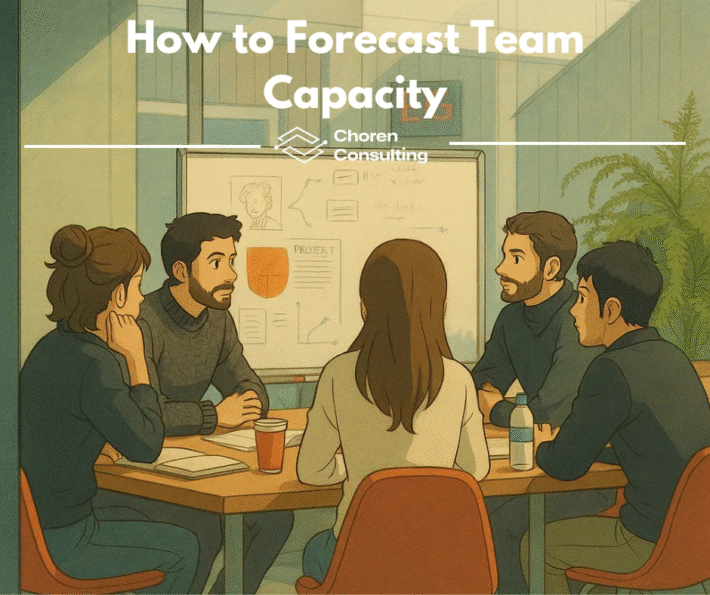5 Signs Your Resource Allocation Strategy Is Broken (And How to Fix It)

Introduction (Informational / Awareness)
Effective resource allocation is crucial for operational success. Yet many organizations miss the early warning signs of a failing strategy, leading to overworked teams, project delays, budget overruns, and ultimately stalled growth. Without a proactive strategy, resource bottlenecks can compound into major operational failures.
In this guide, we’ll highlight five key indicators that your resource allocation strategy needs immediate attention and show you how Choren’s advanced forecasting tools can correct course to drive sustainable outcomes.
1. Consistent Project Delays
Project delays often indicate chronic forecasting issues. When leadership underestimates resource needs or lacks real-time visibility, delays cascade across departments. Delayed projects lead to dissatisfied clients, lost revenue opportunities, and reputational damage.
Consistent delays also demoralize project teams, leading to decreased productivity and eventual turnover. Teams lose confidence when deadlines become meaningless.
Causes:
- Poor capacity forecasting.
- Underestimation of resource needs.
- Lack of real-time project tracking.
Remedies:
- Regularly adjust project scopes based on real-time analytics.
- Use Choren’s CRM-integrated resource planning to proactively balance workloads.
- Incorporate rolling forecasts updated monthly, not quarterly.
- Set up project risk assessment frameworks to anticipate bottlenecks before they impact timelines.
- Encourage milestone reviews at 25%, 50%, and 75% project completion to catch allocation issues early.
2. Employee Burnout and Low Morale
A hidden cost of poor resource allocation is high employee turnover. Beyond audits, proactive workload balancing using AI-driven scheduling ensures no single team member becomes a bottleneck.
Burnout often leads to a vicious cycle where high performers absorb even more work when peers leave. Identifying workload stress patterns before attrition begins is critical.
Causes:
- Over-allocation of critical team members.
- Ignoring early signs of workload stress.
- No automated workflow distribution.
Remedies:
- Integrate automated task management within Choren Consulting CRM.
- Conduct quarterly resource audits.
- Prioritize balanced workload assignment via smart scheduling.
- Develop employee feedback loops that anonymously surface workload concerns to leadership.
- Introduce wellness KPIs alongside project KPIs to maintain a healthy workforce.
3. Resource Conflicts Across Projects
When multiple projects battle for the same limited resources, operational chaos follows. Without centralized visibility, different managers unknowingly double-book critical resources.
These conflicts often result in leadership escalation meetings, firefighting, and resentment among project managers. Long-term, unresolved resource conflicts fracture organizational alignment.
Causes:
- Lack of centralized resource visibility.
- Siloed project management practices.
Remedies:
- Centralize resource allocation decisions.
- Implement a transparent allocation calendar accessible through Choren’s internal forecasting platform.
- Promote interdepartmental resource sharing with clear prioritization rules.
- Use Choren CRM’s Resource Calendar integrated with capacity forecasting alerts.
- Standardize resource booking protocols across all teams.
Learn more about effective Strategic Resource Allocation.
4. Frequent Budget Overruns
Uncontrolled budgets often reflect poor planning, not just scope creep. Budget leaks often stem from untracked micro-changes in resource scopes.
Financial overruns erode stakeholder trust and jeopardize future funding approvals. Projects that regularly exceed budgets are often first to face cuts in strategic planning cycles.
Causes:
- Misalignment between resource planning and financial forecasting.
- Untracked scope creep increasing costs.
Remedies:
- Tie resource allocations directly to budget forecasts using Choren’s Financial Ecosystem models.
- Set automated alerts for overuse thresholds.
- Improve change management processes around resource reallocation.
- Implement change control protocols that require resource re-validation for every budget adjustment.
- Build financial contingency buffers based on past resource usage trends.
- Run monthly variance analyses to catch budget risks before they escalate.
5. Missed Growth Opportunities
Rigid resource models cripple scalability and innovation. Agile firms allocate 10–20% of their annual resource capacity to “opportunistic” projects outside of core planning.
Missing new market opportunities because of rigid resource constraints is a leading indicator of eventual market share loss. Growth requires resource flexibility by design, not by accident.
Causes:
- Inflexible or outdated resource allocation models.
- Inability to rapidly scale resources based on new opportunities.
Remedies:
- Utilize predictive analytics within Choren’s resource planning tools.
- Design agile resource pools that can flex based on demand.
- Conduct semi-annual strategic resource allocation reviews.
- Establish quarterly strategy reviews dedicated solely to resource agility planning.
- Encourage cross-training among employees to expand flexible deployment capabilities.
- Identify “growth reserve” resources in annual planning cycles for opportunistic deployment.
Bonus Section: How to Transition to Smarter Resource Management
Transitioning from reactive to proactive resource management requires deliberate planning. Start by auditing your current resource usage patterns. Identify bottlenecks, underutilized capacities, and skills gaps. Then, align new resource strategies with business objectives, not just project demands.
Leverage Choren’s CRM forecasting and smart allocation tools to centralize visibility, automate balancing, and enable predictive planning. Remember: scalable, agile resource models are foundational for growth in a volatile market.
Companies leading in resource flexibility often see 30% faster time-to-market compared to their peers, according to Gartner benchmarks. Building proactive resource flexibility is a competitive advantage.
Call to Action (Wrap-up)
Don’t wait for small inefficiencies to snowball into major setbacks.
The right resource strategy doesn’t just prevent failures — it accelerates success. Empower your team with smarter forecasts, agile allocation models, and proactive growth capacity.
Book your personalized Resource Strategy Session now or Explore our CRM Forecasting Tools and future-proof your operations.




